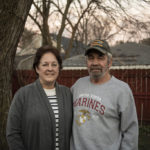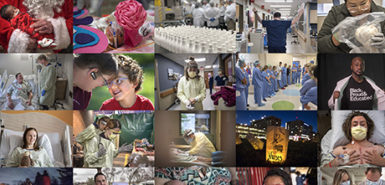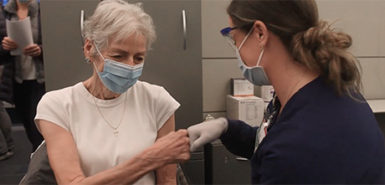George Grzybowski, 70, watched as the Spectrum Health vehicle pulled into the driveway of his Wyoming, Michigan, home.
Two sonographers emerged, masks covering their faces.
Given the COVID-19 pandemic, Grzybowski had been wary of traveling into Grand Rapids for an appointment.
So when Lindsey Nawrocki, a Spectrum Health ultrasound technician, called him to arrange for in-home imaging, he felt only too pleased to accept the offer.
“The choice is up to the patient,” Nawrocki said.
During the COVID-19 shutdown, Nawrocki worked with vascular surgeons who identified patients with urgent needs. She explained to patients how Spectrum Health created an in-home imaging service.
The program started in March 2020 and resumes as the need arises.
The program’s patients were all screened beforehand for COVID-19 symptoms.
“The mobile sonographers are also screened multiple times for COVID,” Nawrocki said.
Grzybowski, suffering from peripheral artery disease for the past two decades, qualified as a patient with urgent needs.
Bouts of soreness
“It started in 2000,” Grzybowski said. “I went hunting with my brother in the woods. We had a mobile home on the property and I had to rest at the trailer when I got there. I could hardly walk. It took three hours to get the feeling back in my left foot.”
He went in to see his doctor.
Robert Cuff, MD, a vascular surgeon at Spectrum Health Vascular Surgery on Lake Drive, diagnosed him with peripheral artery disease and scheduled him for surgery.
Peripheral artery disease occurs when cholesterol and fat accumulations lead to a narrowing of the artery and a restriction of blood flow to tissue.
Leg numbness or weakness is a frequent symptom.
Risk factors are age—60 or older—as well as high blood pressure, smoking, high cholesterol, diabetes and a family history of vascular disease.
Grzybowski had high blood pressure. He also smoked.
“In that first surgery, Dr. Cuff made an incision from my ankle to my groin,” he said. “I missed a couple months of work. I worked as a baker at a bakery in Grand Rapids back then. I didn’t have any problems with my leg again, not until 2011.”
He suffered leg pain and muscle soreness. Dr. Cuff performed a bypass that year to alleviate the pain.
That worked until 2015, when the soreness returned. Tests showed an 85% blockage, requiring another procedure.
More work followed over the years.
“I had surgery again in April 2019,” Grzybowski said. “And by August it was hurting again.”
Home imaging
In April 2020, Grzybowski called Dr. Cuff to complain about pain and weakness in his leg.
The doctor immediately added Grzybowski’s name to the urgent list.
“Before COVID-19, we would have had George come in for testing,” Dr. Cuff said. “And in many situations, we can use telehealth—consulting with patients through technological means.”
But arterial disease also requires imaging.
“For George, we needed to do an ankle-brachial index and ultrasound of his bypass graft to check blood pressure in his ankle and see if his graft was functioning.” Dr. Cuff said.
Spectrum Health designed the home imaging program for patients like Grzybowski.
“To my knowledge, it’s the first of its kind in Michigan,” Dr. Cuff said.
Without the program, Grzybowski would have faced a two- to three-month wait.
“And that could have led to a failed bypass graft, limb risk, and possible in-patient surgery and a hospital stay,” Dr. Cuff said.
The program brings portable imaging equipment directly into the patient’s home. The medical team can visit four to five patients per day, Monday through Thursday, with results available by virtual visit or phone call with a vascular surgeon the following day.
Meeting critical needs
Spectrum Health sonographers Mark Kluisza and Liz Ralston visited Grzybowski’s home on April 28.
On every visit, they call from the vehicle before arriving to ensure the patient has remained free of COVID-19 symptoms since the initial scheduling call.
“And to give them a heads up we were coming,” Ralston said.
They haul all their portable equipment into the patient’s home to perform the tests.
“When I scanned George, Mark and I instantly noticed his results had drastically changed from his prior imaging,” Ralston said.
It highlighted some troubling developments.
“He wasn’t having serious problems, but he was close to graft failure,” Kluisza said. “Liz was scanning him and I could see the velocities within the graft were low.
“While she was still scanning him, I went out to the car, called the office, and I talked to Dr. Christopher Chambers, a vascular surgeon, and set up a time to get the surgery.”
Two days later, Grzybowski attended outpatient surgery at Spectrum Health.
“George underwent an angiogram and angioplasty with a stent in the severely narrowed artery placed above the graft,” Dr. Cuff said.
“It was a smaller incision this time,” Grzybowski said. “Right side of my groin, through and across. The doctor ballooned the artery to clear it and open it up. I was able to go home the same day. And it no longer hurts.”
By his June 6 follow-up appointment, Grzybowski’s leg pain had subsided. Tests showed blood flow in his leg had nearly returned to normal.
He has since returned to his favorite activities, including golf and helping friends and neighbors paint their houses.
“I’m also cutting down a whole lot on my smoking,” Grzybowski said. “My wife is trying to get me to quit. I’m also drinking more water and walking a lot more, as my doctor directed me.”
Dr. Cuff said the in-home imaging program served a need during the stay-at-home order.
“We’re discussing future use of the program in rural counties and for people who have difficulty coming into the office, such as the elderly,” Dr. Cuff said. “With the expansion of telemedicine, we are thinking that this could be beneficial beyond the pandemic. We have been able to catch critical needs in our patients—and our patients seem to really appreciate it.”
Sonographer Kluisza agrees.
“I believe the in-home program was very valuable,” he said. “We averaged a critical finding a week.”







 /a>
/a>
 /a>
/a>
 /a>
/a>